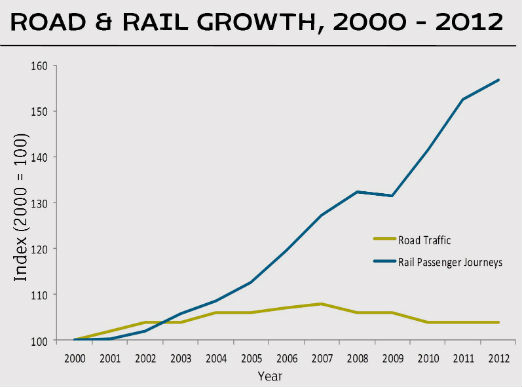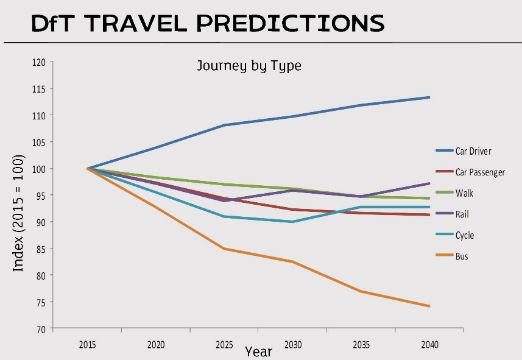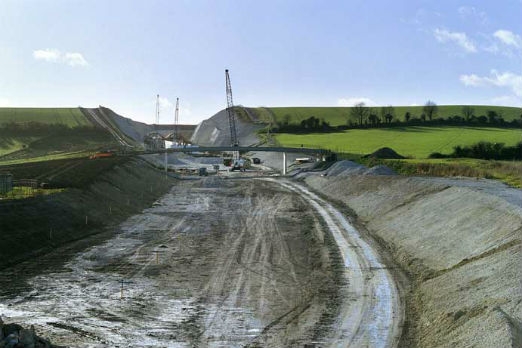
The wrong policies at the wrong time
During the first decade of the 21st century, road traffic was generally falling, even though the overall cost of motoring was getting cheaper compared with public transport. This difference may have finally have reached its limit, with traffic rising once again in 2014. The Department for Transport forecasts that by 2040 how we travel will have fundamentally changed. They are predicting a fall in the proportion of trips where people walk, cycle and take the bus and less people sharing journeys. Just more of us in our cars, by ourselves, driving up air pollution, suffering from ill health, with the countryside suffering to make way for new roads.
But because building more roads leads to even more people deciding to drive, increasing capacity to tackle congestion is always likely to fail in the long term.

Source: Department for Transport
CPRE believes the Government should be working to end car dependency by widening travel choices. Considering the evidence, it makes no sense for it to be embarking on the biggest road-building programme since the 1970s.

Source: travel written question
Stopping damaging roads
CPRE is currently fighting to protect our most precious countryside from the threat of the Government road-building programme, especially highly damaging proposals such as the A27 though part of the South Downs National Park and the A303 past England’s iconic Stonehenge World Heritage Site (see below).
A27 ARUNDEL BYPASS
A new five kilometre dual-carriageway bypass is planned to be built around Arundel in West Sussex. The road will have dire consequences for the local environment, cutting through the South Downs National Park, as well as wiping out a huge section of precious ancient woodland. The proposal will also have a negative impact on the character and setting of this historic town, while increasing pressure to widen the A27 in other parts of the National Park.
Arundel already has a bypass that was built in the 1970s but, rather than tackle traffic levels at source, local councillors and business people are now supporting plans to ‘bypass the bypass’ and to construct yet another damaging road. However, we believe the best course of action for Arundel is to invest in improving public transport along the coast and in nearby towns, giving locals and visitors alike easier access to the town, the National Park and coastal areas.
Arundel would benefit greatly from a major upgrade to the existing south coast rail link which serves the town. An overhaul of local bus services – to link up towns with train access – would also widen people’s travel choices and help reduce car dependency.
Currently, this lack of infrastructure forces many residents and visitors into their cars simply to get across town. By making provision for safe cycling and walking routes across the A27, a 10 to 15 minute walk, or an even shorter cycle, could replace these unnecessary car journeys.
A303 STONEHENGE
The proposed scheme for Stonehenge is to widen the A303 past this internationally important landmark, creating a new dual carriageway. If that goes ahead, it will rip through the rich and diverse landscape of at least one Area of Outstanding Natural Beauty, while causing permanent damage to England’s most famous World Heritage Site and its setting.
While we welcome plans to route a section of the road underground, the proposed tunnel is too short. A mile of the new dual carriageway will still be bulldozed at ground level, and then set in deep cuttings through a landscape described by UNESCO as “without parallel”. We are campaigning to get the length of the tunnel extended to ensure this unique and precious site is preserved.
A £2bn budget has been allocated for creatin the dual carriageway, while improved links to the west of England by rail are being side-lined. There are two railway lines that run parallel to the existing road and, with investment, these could provide a viable alternative to the A303 and reduce pressure on this notoriously busy stretch of road. We want to see a more balanced approach to transport investment to include these railway lines being upgraded, stations reopened, more frequent and faster services, together with improved local bus services.
CPRE supports the campaign by Stonehenge Alliance to protect the World Heritage Site.




